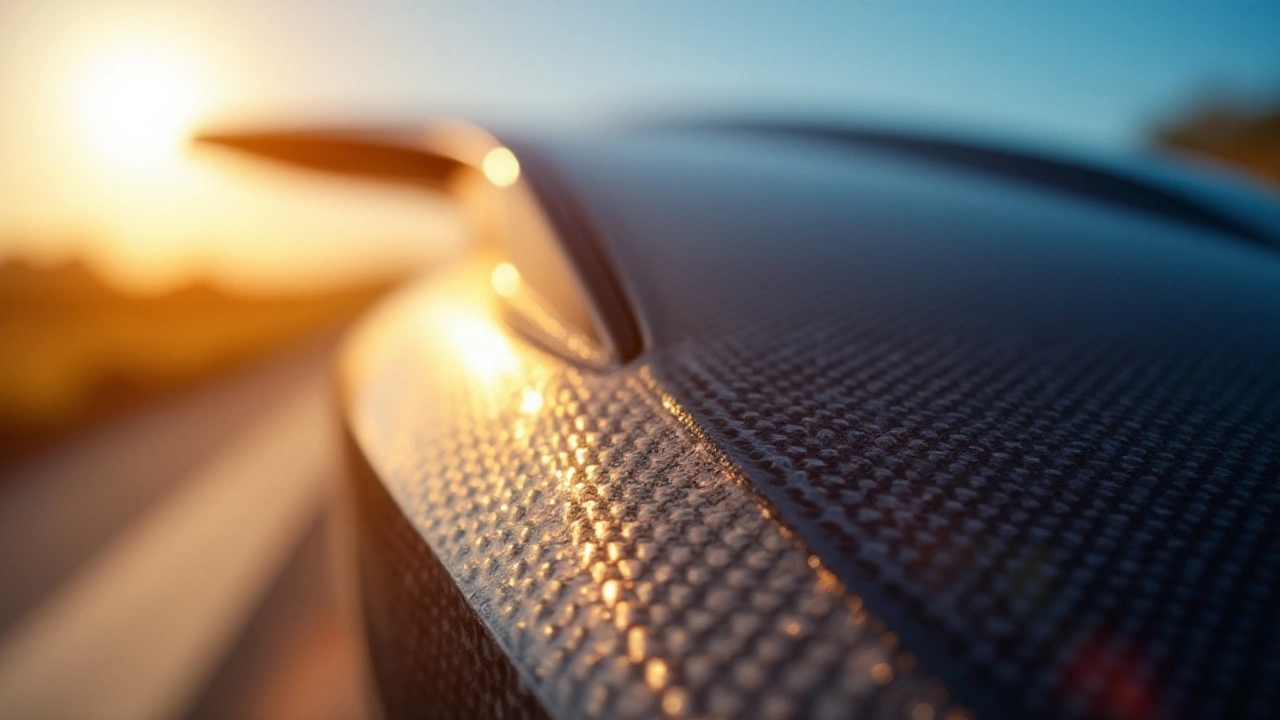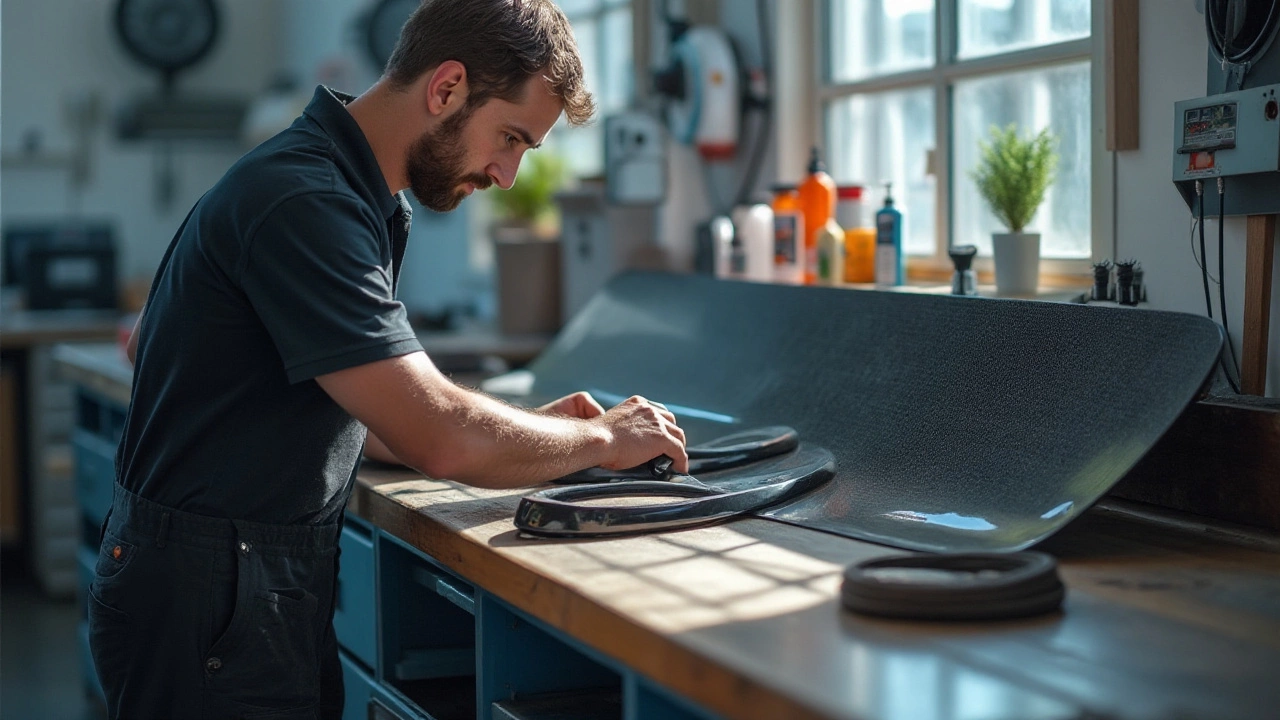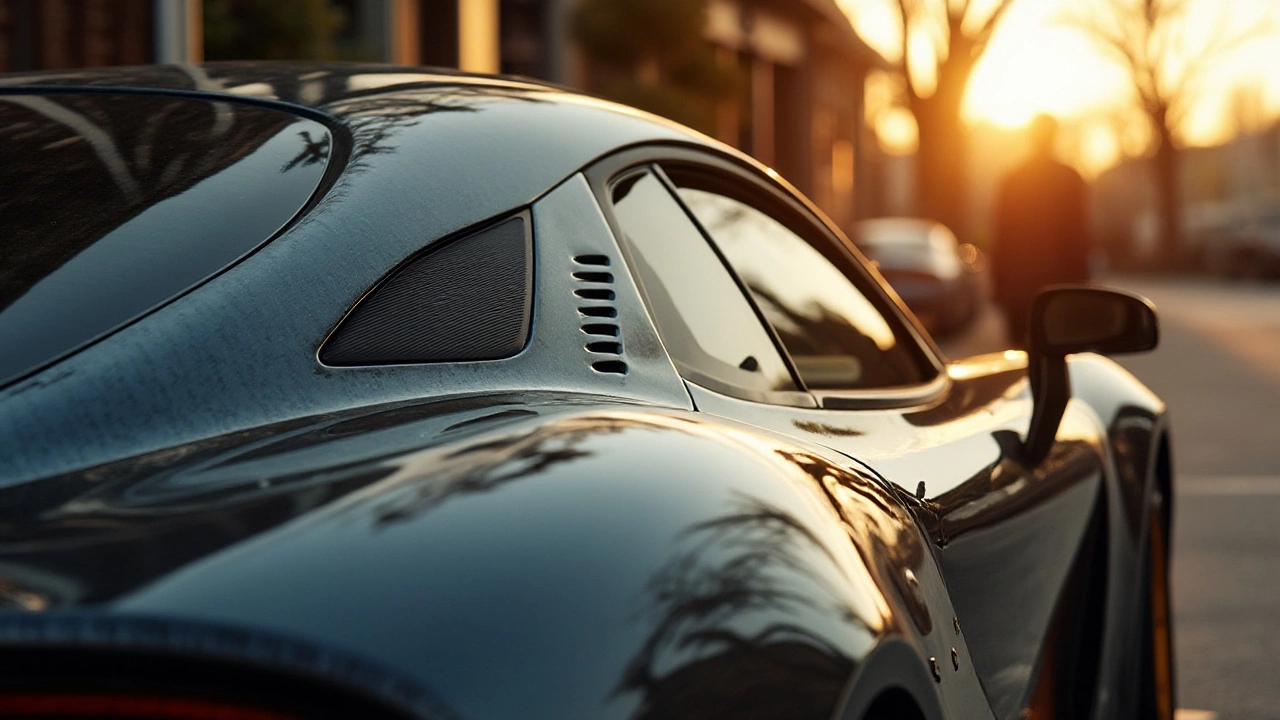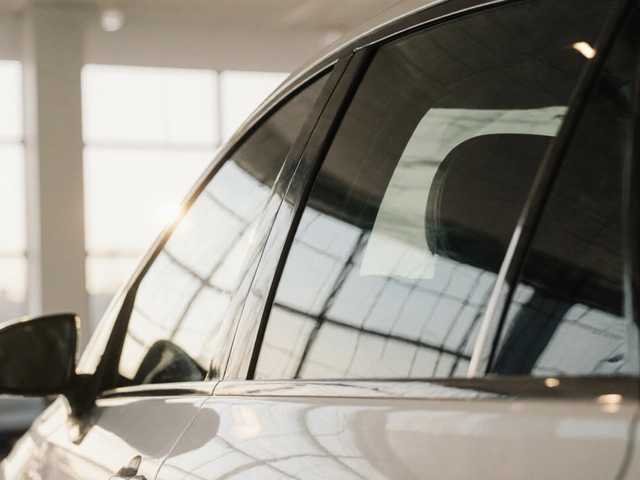Carbon fiber is celebrated in the automotive world for its impressive strength-to-weight ratio, making it a go-to for motor enthusiasts looking to enhance performance without adding unnecessary heft. Yet, one question continues to linger among car owners and builders: How does carbon fiber hold up against the relentless rays of the sun?
The concerns are real, especially when it comes to car parts like spoilers that are continually exposed to various weather conditions. In this exploration, we'll take a closer look at how sunlight can impact carbon fiber materials, distinguishing myth from reality. Is your sleek spoiler at risk of cracking under sunny conditions, or is carbon fiber more durable than we give it credit for?
- Understanding Carbon Fiber
- The Effect of Sunlight
- Signs of Damage
- Maintenance Tips
- Longevity and Care
Understanding Carbon Fiber
Carbon fiber is an advanced material that has revolutionized several industries, most notably aerospace, automotive, and sporting goods. What sets carbon fiber apart from other materials is its remarkable combination of strength and lightness. Composed primarily of strong thin fibers, it is distinguished by its unique crystalline structure which gives it such formidable properties. Imagine a material that's five times stronger than steel but significantly lighter. This is why within the automotive industry, particularly for performance vehicles, carbon fiber has become synonymous with speed and efficiency.
The manufacturing process of carbon fiber involves the weaving of strands of carbon atoms, bound together by a resin. This method not only equips the material with high tensile strength but also enhances its resistance to external pressures. And while this speaks volumes about its capabilities, it’s crucial to understand that carbon fiber’s allure isn’t just about its achievement in strength-to-weight ratios. There's an elegant, glossy finish to it that appeals aesthetically to car enthusiasts wanting a sleek, modern look for their vehicles. In fact, a 2022 study highlighted that about 40% of the carbon fiber produced globally goes directly into the automotive sector.
“The transition towards lightweight materials such as carbon fiber is not just a trend but an imperative as automotive industries strive towards sustainability and performance,” states Dr. Emily Vance, a materials scientist specializing in composites.
This drive for sustainability is important. Lighter vehicles consume less fuel and, hence, ensure better fuel efficiency, which ultimately reduces emissions. The material is relatively environment-friendly over its lifecycle, as the need for fewer raw materials and reduced fuel consumption helps cut down on the carbon footprint.
While carbon fiber clearly dominates in terms of advantages, new users often worry about its cost and complexity in the repair process. Yes, carbon fiber can be more expensive than its traditional counterparts like steel or aluminum, but it’s important to weigh initial expenditure against long-term benefits. Although repairs can be tricky due to its composite nature, the market continues to evolve with more accessible and economical repair kits that cater to minor damages. The key takeaway here is understanding cost vs benefit — the efficiency carbon fiber brings to the table often outweighs initial costs when considering its lifespan and performance benefits.
The Effect of Sunlight
When it comes to car carbon fiber spoilers, one major concern for both enthusiasts and everyday drivers is how these lightweight materials stand up to the relentless exposure of the sun. This isn't just about maintaining that glossy aesthetic appeal, but also ensuring that structural integrity isn't compromised over time. Carbon fiber is naturally resistant to a range of environmental factors; however, consistent sunlight exposure over extended periods can lead to noticeable changes. In particular, while carbon fiber itself does not crack easily under sun exposure due to its rigidity and strength, the resin that binds the fibers can potentially degrade. This resin is susceptible to ultraviolet (UV) rays, which are particularly potent in regions with high sun exposure, possibly leading to discoloration and, in extreme cases, damage to the structural integrity.
To delve deeper into this, it helps to know that automotive-grade carbon fiber components are often coated with protective layers such as UV-protective clear coats. These coatings are crucial in deflecting harmful rays, which can otherwise penetrate and weaken the resin matrix over time. Several studies have shown that prolonged sunlight can cause a gradual degradation of these coatings, meaning routine maintenance and re-coating could be necessary to prevent damage. According to Dr. Sarah Thompson, a materials scientist specializing in composite materials, "Adequate protection against UV rays can significantly extend the lifespan of carbon fiber components in vehicles, especially in regions with high solar exposure."
One might wonder if there's empirical data to support these observations. Indeed, there is evidence suggesting that, without the use of UV coatings, carbon fiber can experience reduced tensile strength. Below is a simplified data table from a detailed study on UV damage to carbon fiber composites over a span of two years.
| Exposure Time | Tensile Strength Reduction (%) |
|---|---|
| 6 months | 3% |
| 1 year | 7% |
| 2 years | 12% |
As you can see, while there’s a gradual reduction in tensile strength over time, adequate countermeasures can help mitigate these effects largely, maintaining both the appearance and performance of your vehicle enhancements. Owners are advised to regularly check for signs of resin aging and reapply protective coatings when needed. Both regular inspections and maintenance are key to ensuring that carbon fiber components continue to perform optimally without succumbing to the elements. Sun exposure, while persistently challenging, can indeed be tackled effectively with the right knowledge and care strategies.

Signs of Damage
When it comes to carbon fiber spoilers, one of the key concerns is identifying the signs of damage, particularly from sun exposure. Unlike conventional materials, carbon fiber doesn't rust or corrode, but it's not entirely immune to harm. The first thing you might notice is discoloration. Over time, the rich black weave of carbon fiber can start to fade, turning into a dull gray, especially if the protective clear coat has worn off. The sun's ultraviolet (UV) rays can indeed be punishing without proper UV-resistant coatings.
An astute observer might also spot hairline cracks on the surface. These cracks are often the result of prolonged exposure combined with other stressors like extreme temperature fluctuations. While the material remains structurally intact, these tiny fissures can grow over time, leading to aesthetic concerns and potential structural issues. A careful inspection, preferably under good lighting, will help in noticing such damage early before it escalates.
Audible and Visual Cues
Another indicator that your carbon fiber spoiler might be suffering is a change in sound. Tapping the surface of a healthy carbon fiber component with a knuckle produces a consistent solid sound, while damaged areas might return a duller or hollow echo. Additionally, you might also notice bubbling or peeling on the surface. This often occurs when the bonding resin separating the carbon layers begins to fail, possibly due to intense heat exposure, resulting in visible surface inconsistencies.
Listen to the warning from automotive expert James Richards:
"Regular checks are your best defense against carbon fiber spoiler damage. Don’t wait till it’s too late to fix a small issue that can develop into something costly and extensive."This advice highlights the importance of early detection.
Summary of Damage Indicators
| Indicator | Description |
|---|---|
| Discoloration | Fading from rich black to dull gray; often due to UV rays without adequate protective coating. |
| Hairline Cracks | Tiny cracks that appear under the surface; result from extended sun exposure and temperature changes. |
| Sound Change | A shift from solid to dull or hollow sound upon tapping, indicating potential structural compromise. |
| Surface Bubbling | Peeling or bubbling due to failure of bonding resin, exacerbated by heat. |
Recognizing these signs can save you time and money, preserving both the aesthetic and functional integrity of your carbon fiber components. This meticulous approach ensures that your vehicle continues to perform optimally while looking its best, even under the sun’s relentless gaze.
Maintenance Tips
Maintaining your carbon fiber spoiler’s appearance and performance involves a few strategic steps that will ensure it can withstand the test of time and the blazing sun. When addressing upkeep, regular cleaning ranks high in importance. Dust, dirt, and road grime can harm the surface over time, especially when mixed with abrasive particles. It's advisable to clean the spoiler gently using a microfiber cloth and a mild soap solution. Avoid aggressive scrubbing, and ensure the cloth is damp but not soaked. This way, you prevent creating tiny scratches that could give the sun's rays a foothold for deeper damage.
Once cleaned, protection is key. Applying a UV-protectant wax specifically designed for carbon fiber materials can significantly extend the life of your spoiler. This wax acts as a barrier against the sun’s ultraviolet rays, which can cause dullness or cracking over the long term. Apply it evenly, following the manufacturer's instructions for best results. Some enthusiasts swear by classic brands like Meguiar’s, which has specially formulated products for carbon components. Remember to reapply this protective layer every few months to maintain its efficacy. As an extra step, consider investing in a car cover or indoor parking to shield the spoiler from direct sunlight when your vehicle is not in use.
Temperature fluctuations can affect carbon fiber, so understanding your climate and the implications it holds is beneficial. If you live in regions with extreme weather, it might be useful to inspect the spoiler frequently. Check for any signs of stress or damage, such as cracks or fading. Early detection is crucial for addressing any potential issues before they escalate. If damage appears, consulting with a professional may be beneficial to assess if repairs are needed. According to a specialist from Carbon Composites United, "Regular maintenance not only adds years to your spoiler’s life but also enhances its aesthetics and value." This proactive approach keeps your investment in top shape and prevents small issues from snowballing into costly repairs.
Lastly, consider enhancing the spoiler with protective film. PPF, or Paint Protection Film, is often clear, self-healing, and designed to shield surfaces from UV damage, scratches, and chips. Installing this film on your carbon fiber spoiler adds another protective layer, providing peace of mind that your spoiler is safeguarded against potential damage. Whether you’re racing down the highway or parked under sunny skies, a well-maintained spoiler not only adds to the car’s appeal but also speaks volumes about the owner’s attention to detail and care.

Longevity and Care
When it comes to ensuring the longevity of your carbon fiber spoiler, it all starts with understanding the material. This marvel of modern engineering, renowned for its lightweight and high-strength properties, needs a little care to maintain its luster and functionality over the years. Regular upkeep is crucial because, like any automotive component, carbon fiber is subjected to environmental forces that can degrade its appearance and performance if neglected.
A primary concern with carbon fiber is its resilience to prolonged sun exposure. While carbon fiber itself does not inherently crack from the sun's rays, the resin that binds the fibers can be more susceptible to UV damage. Therefore, using a UV-protective coating or wax can significantly reduce the potential for damage. An added benefit of these protective measures is the preservation of the spoiler's sleek aesthetic, which is often a selling point for such upgrades.
Neglecting these care tips might lead to a common issue, often referred to as 'fiber bloom,' where the sun's rays penetrate the resin layer, causing the fibers to appear cloudy and dull. To combat this, make it a habit to wash your car regularly, maintaining a clean surface free of dirt and debris. This prevents any abrasive particles from scratching the resin surface during washes, especially when using rough cloths or brushes.
In an insightful remark, James Smith, an expert in automotive materials, stated,
“Keeping carbon fiber components in a garage or under a cover when not in use can significantly extend their lifespan. It's an easy preventative measure that makes a big difference over time.”Storage plays a huge role, with indoor or covered protection helping maintain both the material integrity and the finish of your spoiler. Using car covers specifically designed to repel UV radiation can also prove beneficial and is often a small investment for long-term gains.
Another essential tip is to inspect your spoiler periodically for any signs of damage such as chips or cracks. Left unchecked, these small issues can expand, compromising the durability of the spoiler. If any damage is detected, addressing it promptly with professional help ensures that the issue doesn’t escalate. Remember that tinkering with repairs without expertise can sometimes make matters worse.
For those looking to go a step further in protection, consider ceramic coating applications which offer comprehensive shielding against environmental factors, including UV rays. These coatings create an additional hardened layer, amplifying both aesthetic appeal and protection. The complexity might require professional handling, yet the results are often well worth it. Additionally, manufacturers occasionally provide detailed maintenance guidelines that specify the most suitable cleaning products and practices for their products.






